Magnetic polyurethane elastomers with wide range modulation of elasticity
Tetsu
Mitsumata
* and
Suguru
Ohori
Department of Polymer Science and Engineering, Graduate School of Engineering, Yamagata University, 4-3-16 Jonan, Yonezawa, 992-8510, Japan. E-mail: tetsu@yz.yamagata-u.ac.jp; Fax: +81 (0)238 26 3101; Tel: +81 (0)238 26 3078
First published on 24th March 2011
Abstract
A new magnetorheological elastomer that demonstrates drastic and reversible changes in dynamic modulus in air was obtained. The magnetic elastomer consists of polyurethane and carbonyliron particles. The magnetic elastomer with a volume fraction of 0.29 exhibited a reversible increase by factors of 277 of the storage modulus and 96 of the loss modulus upon a magnetic field of 500 mT. The elastomer underwent high mechanical toughness with a braking strain exceeding 0.8, and demonstrates the giant magnetorheological behavior for half a year after the synthesis without degradation.
1. Introduction
A magnetorheological (MR) material is an intelligent material in which rheological properties can be controlled by a magnetic field. It is widely known that the viscosity of MR fluids alters in response to the application of magnetic fields. Not only in fluids but also in solids, many attempts to fabricate MR materials have been performed using soft materials such as synthetic polymer gels,1silicone elastomers,2–7 and rubbers.8,9 Details of the past investigations about MR gels and elastomers have been reviewed in the literature.10,11 The stability of magnetic particles in MR solids is superior to that in MR fluids because of the high viscosity of MR solids, e.g. the sedimentation of magnetic particles does not take place easily in MR solids. However, the MR response of solids is generally small compared to that of fluids. This originates mainly because the magnetic particle is difficult to move and form a chain structure in solids. So far, many investigations have been carried out from various points of view; magnetodeformation of soft rubbers,12 the influence of geometries between particle alignment and applied magnetic field on the magnetoelastic effect,13 magnetoelasticity and its applications to dampers and seals.14,15 In many cases for MR solids, the relative change in the storage modulus (the ratio of storage moduli at magnetic field to off-fields) was several times or less.We have investigated the effect of magnetic fields on the dynamic modulus of magnetic gel based polysaccharides, and found the giant negative MR effect.16–18 The magnetic gel exhibits reductions in the storage Young's modulus of ∼107 Pa and in the loss modulus of ∼106 Pa by only applying a magnetic field of 1000 mT, not under a constant magnetic field. The magnetic gel contains a particle network which is made of many fragile (physical) contacts between magnetic particles, and the network is destroyed by the transitory magnetic field. This fact reveals important information: a heterogeneous dispersion (particle network) obstructs the MR effect, while a random dispersion leads to drastic changes in dynamic modulus.
Based on the above findings concerning the negative MR effect, we succeeded in synthesizing a new class of magnetorheological gels that demonstrate drastic and reversible changes in dynamic modulus without using strong magnetic fields.19 At zero magnetic field, the storage modulus of the magnetic gel is extremely low with ∼104 Pa although the gel contains a large amount of particles with ϕ ∼ 0.30, resulting from random dispersion of the magnetic particles in the gel. The magnetic particles, under a magnetic field, align to the magnetic lines of force and form a chain structure contributing to high storage modulus exceeding 4 MPa. The importance of random dispersion can also be understood from the recent report20 that a highly swollen physical gel with a storage modulus of ∼10 kPa demonstrates a modulus increase of up to 60 times.
Thus, we now obtained magnetic-field sensitive gels with wide modulation of elastic modulus; however, magnetic gels are, in general, mechanically fragile since magnetic gels are swollen by a large amount of water. It is also a serious issue that the MR effect is strongly affected by the water content of the gel. These problems limit the practical use of magnetic gels and should be improved using non-swelling materials such as elastomers or rubbers. Generally, the elastic modulus of elastomers is higher than that of polymer gels, therefore, the magnetorheology of magnetic elastomers can be expected to be decreased. In this paper, we tried to synthesize a new magnetic elastomer consisting of polyurethane with extremely low elastic modulus and magnetic hydrogels, and investigated its magnetorheology.
2. Experimental procedure
Synthesis of magnetic elastomers
Magnetic elastomer was synthesized from liquid diphenylmethane diisocyanate, castor oil-based polyester polyol, carbonyliron magnetic particles (BASF Japan), and trace amounts of organotin compounds as a catalyst. The diphenylmethane diisocyanate, polyester polyol, catalyst, and carbonyl iron (CI) particles were mixed using a mechanical mixer for 30 min. The ratio of liquid diphenylmethane diisocyanate to the polyol [NCO]/[OH] was kept at 0.33. The mixture was poured into a glass mold and cured for 3 h at 100 °C in air. The diameter of CI particles was determined to be 2.8 μm by a particle size analyzer (Shimazu SALD-7000). The shape of the CI particles was observed using a SEM with an accelerating voltage of 20 kV (VE-9800, KEYENCE) (Fig. 1(a)). The weight concentration of CI particles was varied from 0 to 70 wt%, which corresponds to volume fractions of 0–29 vol%. The volume fraction was calculated using the densities of the magnetic elastomer, polyurethane elastomer (1.00 g cm−3), and the CI particles (6.293 g cm−3).19 The saturation and remanent magnetization of CI particles were measured to be 207 and 1.3 emu g−1, respectively, by a vibrating specimen magnetometer (Toei Co, Ltd.). Carrageenan (CA) magnetic gels, for comparison, were synthesized by a similar method reported previously.19 The CA concentration was kept at 1 wt%.Rheological measurements
Dynamic viscoelastic measurements were carried out using a rheometer (MCR301, Anton Paar) with a non-magnetic measuring plate, which is a special plate for measurement under magnetic fields. For strain sweep measurements, the frequency was kept at 1 Hz, and the strain amplitude was varied from 10−6 to 10−2. For the measurement of magnetic-field response, the frequency and strain were kept at 1 Hz and 10−4, respectively. The temperature was controlled at 20.0 °C during the viscoelastic measurement. The samples were disks with dimensions of 20 mm diameter and 1.5 mm thickness. The breaking point of magnetic elastomers was measured at room temperature using a uniaxial compression apparatus (STA-1150, Orientec) with a compression speed of 100 mm min−1. The sample was a disk of 8 mm thickness and 35 mm in diameter.3. Results and discussion
Fig. 1(b) displays the effect of magnetic field on the strain dependence of storage modulus for a magnetic elastomer with a volume fraction of magnetic particles ϕ = 0.29. In the linear viscoelastic regime, the storage modulus at 0 mT (off-state storage modulus) was 6.45 kPa, and the storage modulus at 500 mT was 1.55 MPa. The high modulus under the magnetic field is attributed from a structural change from random dispersion to chain structure of magnetic particles. As discussed in a previous paper,19 this huge increase in the storage modulus cannot be explained by only the magnetic interaction acting on magnetized particles. The storage modulus of the magnetic elastomer maintained a high modulus with 0.57 MPa even at γ = 10−2. Our previous paper reported a rheological feature that the storage modulus remarkably decreases at high strains,18 called the Payne effect,21 which originates from the destruction of the particle network. The high storage modulus under magnetic fields means that the chain structure formed in the magnetic elastomer is hard to destroy by strain compared to magnetic hydrogels. When the magnetic field was reduced to 0 mT, the storage modulus decreased to 17.6 kPa, which is higher than the off-set storage modulus. This indicates that CI particles do not perfectly recover their original positions before applying the magnetic field. The formation of aggregates in the elastomer may be possible due to weak remanent magnetization (∼1.3 emu g−1) of CI particles, although apparent aggregation was not observed.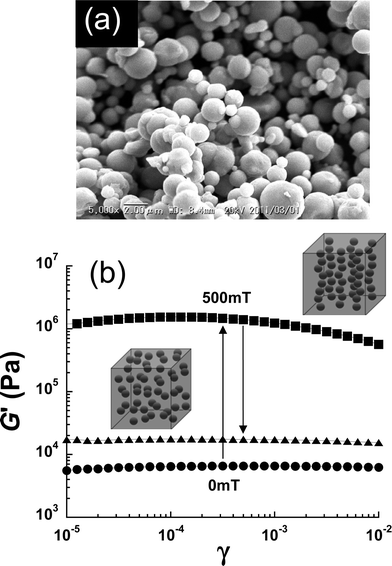 | ||
| Fig. 1 (a) Magnetic particles used in the present study. (b) Effect of magnetic field on the strain dependence of storage modulus for polyurethane elastomers containing CI particles (ϕ = 0.29). | ||
Fig. 2(a) shows the strain dependence of storage modulus G′ for magnetic elastomers with various volume fractions of CI particles. All samples exhibited the storage modulus independently of the strain, indicating linear viscoelasticity. Fig. 2(b) shows the storage modulus at γ ∼ 10−4 as a function of the volume fraction. Interestingly, the storage modulus of magnetic elastomers was independent of the volume fraction of CI particles although the volume fraction was raised up to 0.29. The solid line in the figure represents the relation between the storage modulus and the volume fraction of dispersed particles based on the Einstein equation:22,23G′ = G′0(1 + 2.5ϕ), where G′ and G′0 are the storage moduli of the magnetic elastomer and polyurethane elastomer without magnetic particles, respectively. The storage modulus of the magnetic elastomer almost obeyed the above equation, indicating the CI particles are randomly dispersed in the elastomer. As the storage modulus did not show a rapid increase at the high volume fraction end, the interaction between CI particles and matrix is considered to be extremely weak.
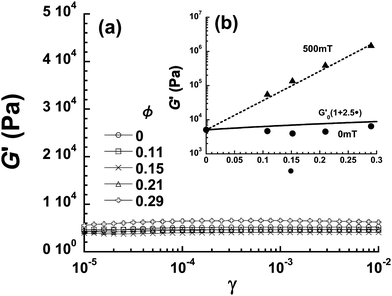 | ||
| Fig. 2 (a) Strain dependence of storage modulus for magnetic elastomers with various volume fractions. (b) Storage modulus in the linear viscoelastic regime at 0 and 500 mT as a function of the volume fraction of CI particles. Solid line represents the Einstein equation, broken line is a guide to the eye. | ||
Fig. 3 demonstrates the change in storage modulus and loss modulus of magnetic elastomers in response to stepwise magnetic fields of 500 mT (=39.8 kA m−1). The G′ values in the reversible regime (during the time 120–240 s) were analyzed. The magnetic elastomer demonstrated huge, exceeding two orders of magnitude, and reversible changes in the storage modulus synchronized with the magnetic field. The observed modulus change equals that for magnetic hydrogels demonstrating giant magnetorheology.19,24 However, only the first response, the storage modulus exhibited a slight increase in the modulus after removing the first magnetic field, suggesting the occurrence of a small amount of aggregation in the elastomer. As seen in the following response, the aggregation did not develop by switching the magnetic field. According to the literature,2 the storage modulus of silicone gels with carbonyliron particles increased by 2.5 times at 59 kA m−1 (from 20 kPa to 50 kPa); this would be, as far as we know, the highest value achieved in studies of magnetorheological elastomers. The absolute value of the change in the storage modulus ΔG′ was 1.28 MPa, and the relative change in the modulus G′B500/G′B0 was 180 fold. The change in the loss modulus observed here was ΔG′′ 239 kPa, which corresponds to 65 times the relative change in the loss modulus G′′B500/G′′B0. The loss tangent (tan δ) for the present elastomer is worth mentioning for discussing damping properties. The change in loss tangent for a cis-polybutadiene MR rubber was Δ(tan δ) = 0.02–0.015 by varying the magnetic field from 0 to 700 mT.25 In the present elastomer, the loss tangent altered Δ(tan δ) = 0.15–0.60 in response to the magnetic field 0 to 500 mT, which is a practical level for dampers. This wide range modulation is caused by the drastic change in the distribution of magnetic particles accompanying the local deformation of the polyurethane matrix. Hence, softness of the matrix in which magnetic particle can move easily is needed for MR materials with giant magnetorheological effect.
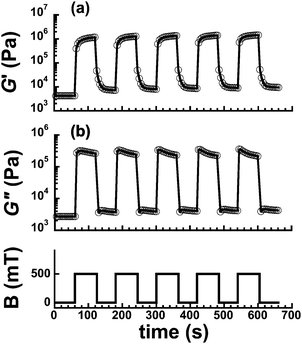 | ||
| Fig. 3 Change in storage modulus (a) and loss modulus (b) at γ = 10−4 for magnetic elastomers (ϕ = 0.29) in response to stepwise magnetic fields (500 mT). | ||
The increment in storage modulus ΔG′ (=G′ B500 − G′B0) and the relative changes in storage modulus due to magnetic field as a function of the volume fraction are shown in Fig. 4. The ΔG′ for magnetic carrageenan gels demonstrating giant magnetorheology is also shown for comparison. The increment in the storage modulus increased with the volume fraction and saturated to approximately 4.8 MPa at ϕ > 0.30. The relative change in the storage modulus increased with the volume fraction, and the value was similar to that for magnetic carrageenan gel. This strongly suggests that the CI particles are able to align along the magnetic lines of force within the polyurethane elastomer, as well as magnetic carrageenan gels.
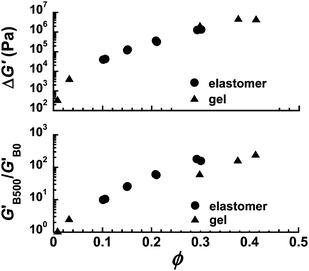 | ||
| Fig. 4 Volume fraction dependence of the increment in storage modulus (top) and relative changes in storage modulus (bottom) at γ = 10−4 for magnetic polyurethane elastomers and magnetic carrageenan gel (500 mT). | ||
Fig. 5 shows the influence of degradation on the magnetorheological properties for magnetic elastomers and carrageenan gels. The storage modulus of magnetic gel stored in air increased significantly within two hours because of waterevaporation from the gel; as a result, the magnetorheological effect was diminished. After 3 h, the magnetic gel lost its softness (solidified), and the MR effect was not observed. In contrast to this, the magnetic elastomer maintained its MR response even after half a year from synthesis. Not only waterevaporation but also freezing of water limits the usage of magnetic gels. The magnetic gel was solidified at the freezing point of the swelling medium, i.e.water, but the obtained magnetic elastomer kept its softness below 0 °C (Tg ∼ −40 °C). Other serious problems for the practical use of magnetic hydrogels are degradation of the magnetic particles and the polymer matrix. The photos in Fig. 5 show the material degradation due to oxidation of CI particles. The color of the magnetic gel was black at synthesis and changed to dark yellow within a few days, caused by the oxidation of CI particles. This leads to a decrease in the magnetic permeability of the magnetic gel as a bulk state; as a result, the MR response is markedly weakened. It has been found by chemiluminescence experiments that natural rubber with large amounts of iron particles underwent degradation by oven ageing.26 It is considered that such degradation is less in the present elastomer compared to magnetic gels or rubbers, because the elastomer does not contain a solvent such as water, and polyurethane is a chemically stable material. It would be important to investigate both the oxidative stability of the present elastomer and the stability of iron particles against humidity.
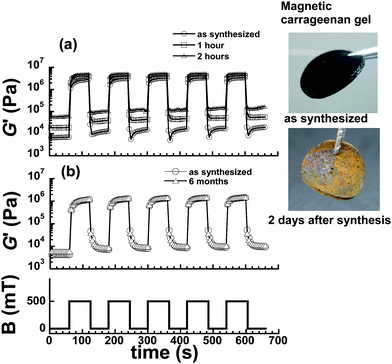 | ||
| Fig. 5 Degradation of magnetorheological response for (a) magnetic carrageenan gel and (b) magnetic polyurethane elastomer. Stepwise magnetic field with 500 mT was applied to the samples (ϕ = 0.29, γ = 10−4). Photo: magnetic gels as synthesized (top) and 2 days after synthesis (bottom). | ||
Fig. 6 shows the stress–strain curves of magnetic carrageenan gels and magnetic elastomers. A breaking point was not seen in the magnetic elastomer up to a strain of 0.8. The magnetic elastomer undergoes high strain due to elastic deformation, which is similar behavior to that of magnetic polyvinyl alcohol gels previously reported.24 Of course, the braking stress for these soft materials must be lower than that of conventional MR elastomers with high off-field elastic modulus, although the breaking point was not observed. It may be that this mechanical feature, high braking strain and low braking stress, enables the magnetic particles to move within the polyurethane matrix. The magnetic carrageenan gel, giant magnetorheological gel, exhibited a breaking point at 0.30 with a breaking stress of 15.9 kPa. It can be considered that these values are enough to cause slight movement of the magnetic particles. However, the low mechanical toughness arising from brittle fracture is a serious problem for practical use. The present magnetic elastomer did not exhibit a permanent strain, while the carrageenan magnetic gel did not recover its original shape after removing the strain (completely collapsed). Thus, the present magnetic elastomers possess both high breaking strain and giant magnetorheology.
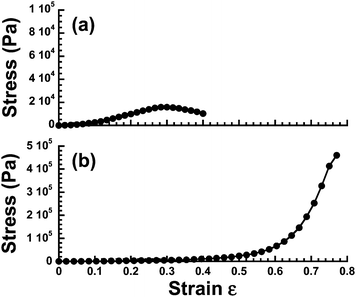 | ||
| Fig. 6 Stress–strain curves of (a) magnetic carrageenan gels and (b) magnetic polyurethane elastomers in the absence of a magnetic field (ϕ = 0.29). | ||
4. Conclusions
We have succeeded in synthesizing magnetic polyurethane elastomers and investigated the magnetorheological properties, mechanical properties, and degradation of the elastomers. The magnetic elastomer exhibited a reversible increase by factors of 277 of the storage modulus and 96 of the loss modulus upon applying a magnetic field of 500 mT, which were nearly the same levels as magnetic hydrogels demonstrating giant magnetorheology. The magnetic elastomer maintained the magnetic field response for half a year after the synthesis. In addition, the magnetic elastomer exhibited high mechanical toughness with a breaking strain exceeding 0.8, and did not show permanent deformation after removing the strain. These features clearly indicate that magnetic elastomers are more suitable as materials working in air than magnetic gels. We firmly believe that this magnetic elastomer with dramatically prolonged lifetime will be widely used in magnetically controllable smart devices in the near future.Acknowledgements
We are grateful to San-Ei Gen F.F.I., Inc. for the offer of samples. This research was supported by T. Hojyo and K. Yamamoto of Panasonic Electric Works Co., Ltd. and Arakawa-ku foundation of Tokyo.References
- T. Mitsumata, K. Ikeda, J. P. Gong, Y. Osada, D. Szabo and M. Zrinyi, J. Appl. Phys., 1999, 85, 8451–8455 CrossRef CAS.
- T. Shiga, A. Okada and T. Kurauchi, J. Appl. Polym. Sci., 1995, 58, 787–792 CrossRef CAS.
- M. R. Jolly, J. D. Carlson, B. C. Munoz and T. A. Bullions, J. Intell. Mater. Syst. Struct., 1996, 7, 613–622 CrossRef CAS.
- J. M. Ginder, S. M. Clark, W. F. Schlotter and M. E. Nichols, Int. J. Mod. Phys. B, 2002, 16, 2412–2418 CrossRef CAS.
- G. Bossis and C. Bellan, Int. J. Mod. Phys. B, 2002, 16, 2447–2453 CrossRef.
- T. Mitsumata and T. Okazaki, Jpn. J. Appl. Phys., 2007, 46, 4220–4224 CrossRef CAS.
- T. Mitsumata, T. Kuribayashi and T. Okazaki, Curr. Trends Polym. Sci., 2009, 13, 11–16 Search PubMed.
- M. Lokander and B. Stenberg, Polym. Test., 2003, 22, 245–251 CrossRef CAS.
- M. Lokander and B. Stenberg, Polym. Test., 2003, 22, 677–680 CrossRef CAS.
- M. Zrinyi, in Polymer Gels and Networks, ed. Y. Osada and A. R. Khokhlov, Marcel Dekker, New York, 2002, ch. 11 Search PubMed.
- G. Filipcsei, I. Csetneki, A. Szilágyi and M. Zrinyi, Advances in Polymer Science, Oligomers, Polymer Composites, Molecular Imprinting, Springer-Verlag, Berlin Heidelberg, 2007, pp. 137–189 Search PubMed.
- L. V. Nikitin, G. V. Stepanov, L. S. Mironova and A. I. Gorbunov, J. Magn. Magn. Mater., 2004, 2072, 272–276.
- Z. Varga, G. Filipcsei and M. Zrinyi, Polymer, 2006, 47, 227 CrossRef CAS.
- S. Abramchuk, E. Kramarenko, G. Stepanov, L. V. Nikitin, G. Filipcsei, A. R. Khokhlov and M. Zrinyi, Polym. Adv. Technol., 2007, 18, 883–890 CrossRef CAS.
- S. Abramchuk, E. Kramarenko, G. Stepanov, L. V. Nikitin, G. Filipcsei, A. R. Khokhlov and M. Zrinyi, Polym. Adv. Technol., 2007, 18, 513–518 CrossRef CAS.
- T. Mitsumata, A. Nagata, K. Sakai and J. Takimoto, Macromol. Rapid Commun., 2005, 26, 1538–1541 CrossRef CAS.
- T. Mitsumata, K. Sakai and J. Takimoto, J. Phys. Chem., 2006, 110, 20217–20223 Search PubMed.
- T. Mitsumata, T. Wakabayashi and T. Okazaki, J. Phys. Chem., 2008, 112, 14132–14139 Search PubMed.
- T. Mitsumata and N. Abe, Chem. Lett., 2009, 38, 922–923 CrossRef CAS.
- H. An, S. J. Picken and E. Mendes, Soft Matter, 2010, 6, 4497–4503 RSC.
- A. R. Payne, J. Appl. Polym. Sci., 1960, 3, 127 CrossRef CAS.
- A. Einstein, Ann. Phys., 1906, 19, 289.
- A. Einstein, Ann. Phys., 1911, 34, 591 CAS.
- K. Negami and T. Mitsumata, Chem. Lett., 2009, 39, 550–551.
- T. L. Sun, X. L. Gonga, W. Q. Jiangb, J. F. Lia, Z. B. Xua and W. H. Li, Polym. Test., 2008, 27, 520–526 CrossRef CAS.
- M. Lokander, T. Reitberger and B. Stenberg, Polym. Degrad. Stab., 2004, 86, 467–471 CrossRef CAS.
| This journal is © The Royal Society of Chemistry 2011 |
